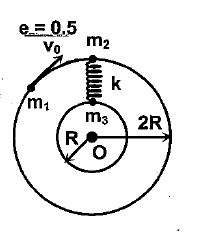
Find the maximum extension in the spring.

A) $\dfrac{{{v_o}}}{4}\sqrt {\dfrac{m}{{5k}}} $
B) $\dfrac{{3{v_o}}}{4}\sqrt {\dfrac{m}{{5k}}} $
C) $\dfrac{{{v_o}}}{3}\sqrt {\dfrac{m}{{5k}}} $
D) $\dfrac{{{v_o}}}{8}\sqrt {\dfrac{m}{{5k}}} $
Answer
217.8k+ views
Hint: The maximum extension of the spring is defined as the elastic limit of the spring which can achieve due to the proportion of physical dimensions. A collision takes place when particles move towards each other and come near to interact and then exert a mutual influence.
Complete step by step solution:
By conservation of linear momentum between $m_1$ and $m_2$ and also by using the coefficient of restitution,
The velocity of $m_2$ just after collision $ = \dfrac{{3{v_o}}}{4}$ $\left( {\because {V_f} = \dfrac{{{m_1}v}}{{{m_1} + {m_2}}}} \right)$
Similarly, after the collision, the maximum extension in the spring occurs when the angular velocity of $m_2$ and m3 about the point O becomes the same.
By conservation of angular momentum about O and by energy conservation,
Velocity of $m_2$ $ = r\omega = 2r\omega = \dfrac{3}{5}{v_o}$ $\left( {\because v = r\omega } \right)$
Similarly velocity of $m_3$ $ = r\omega = r\omega = \dfrac{3}{{10}}{v_o}$ $\left( {\because v = r\omega } \right)$
Thus maximum extension in the spring $ = \dfrac{{3{v_o}}}{4}\sqrt {\dfrac{m}{{5k}}} $ ${\because}$ k = Spring constant
Hence the correct option is B.
Note: 1) A coefficient of restitution equal to zero indicates a perfectly inelastic collision. Also, the coefficient of restitution indicates how elastic or inelastic the collision is.
2) The spring constant is defined as the ratio of the force affecting the spring to the displacement caused by it. It is denoted by k. When stretching a material, the limit of proportionality refers to the point beyond which Hooke’s law is no longer.
3) According to the principle of conservation of momentum, the total momentum of the system is unchanged in the collision process. Collisions are classified as elastic or inelastic based on whether mechanical energy or kinetic energy is conserved or not conserved.
4) The spring is said to be stiff if the spring constant is large and is said to be soft if the spring constant is small.
Complete step by step solution:
By conservation of linear momentum between $m_1$ and $m_2$ and also by using the coefficient of restitution,
The velocity of $m_2$ just after collision $ = \dfrac{{3{v_o}}}{4}$ $\left( {\because {V_f} = \dfrac{{{m_1}v}}{{{m_1} + {m_2}}}} \right)$
Similarly, after the collision, the maximum extension in the spring occurs when the angular velocity of $m_2$ and m3 about the point O becomes the same.
By conservation of angular momentum about O and by energy conservation,
Velocity of $m_2$ $ = r\omega = 2r\omega = \dfrac{3}{5}{v_o}$ $\left( {\because v = r\omega } \right)$
Similarly velocity of $m_3$ $ = r\omega = r\omega = \dfrac{3}{{10}}{v_o}$ $\left( {\because v = r\omega } \right)$
Thus maximum extension in the spring $ = \dfrac{{3{v_o}}}{4}\sqrt {\dfrac{m}{{5k}}} $ ${\because}$ k = Spring constant
Hence the correct option is B.
Note: 1) A coefficient of restitution equal to zero indicates a perfectly inelastic collision. Also, the coefficient of restitution indicates how elastic or inelastic the collision is.
2) The spring constant is defined as the ratio of the force affecting the spring to the displacement caused by it. It is denoted by k. When stretching a material, the limit of proportionality refers to the point beyond which Hooke’s law is no longer.
3) According to the principle of conservation of momentum, the total momentum of the system is unchanged in the collision process. Collisions are classified as elastic or inelastic based on whether mechanical energy or kinetic energy is conserved or not conserved.
4) The spring is said to be stiff if the spring constant is large and is said to be soft if the spring constant is small.
Recently Updated Pages
Elastic Collision in Two Dimensions Explained Simply

Elastic Collisions in One Dimension Explained

Electric Field Due to a Uniformly Charged Ring Explained

Electric Field of Infinite Line Charge and Cylinders Explained

Electric Flux and Area Vector Explained Simply

Electric Field of a Charged Spherical Shell Explained

Trending doubts
Understanding Atomic Structure for Beginners

Ideal and Non-Ideal Solutions Explained for Class 12 Chemistry

Understanding Average and RMS Value in Electrical Circuits

JEE Main 2023 January 29th Shift 2 Physics Question Paper with Answer Keys and Solutions

Understanding the Difference Between Pound and Kilogram

SN1 and SN2 Reactions Explained: Mechanisms, Differences, and Examples

Other Pages
NCERT Solutions For Class 11 Physics Chapter 12 Kinetic Theory - 2025-26

Inertial and Non-Inertial Frame of Reference Explained

Clemmensen and Wolff Kishner Reductions Explained for JEE & NEET

Two identical balls are projected one vertically up class 11 physics JEE_MAIN

Work Energy and Power Class 11 Physics Chapter 5 CBSE Notes - 2025-26

Devuthani Ekadashi 2025: Correct Date, Shubh Muhurat, Parana Time & Puja Vidhi




